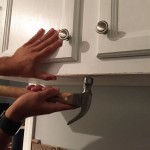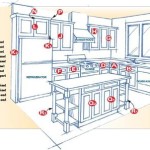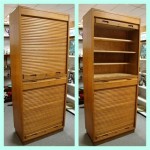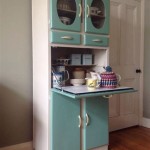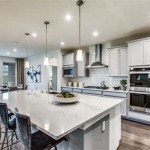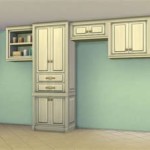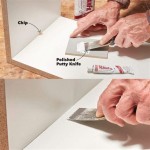Unpainted Kitchen Cabinet Doors: A Comprehensive Guide
Kitchen cabinet doors are a defining feature of any kitchen, contributing significantly to the overall aesthetic and functionality of the space. While pre-finished cabinet doors offer convenience, unpainted kitchen cabinet doors present a versatile and customizable alternative. This article delves into the advantages, considerations, and practical aspects of choosing and working with unpainted kitchen cabinet doors, offering a detailed understanding for homeowners, contractors, and designers.
The appeal of unpainted cabinet doors lies in their inherent adaptability. They provide a blank canvas, allowing individuals to precisely tailor the color, finish, and style of their cabinetry to match their unique design preferences and the existing decor of their kitchen. This level of customization proves particularly valuable when seeking to achieve a specific aesthetic, such as a modern minimalist look, a rustic farmhouse charm, or a vibrant, personalized color scheme.
Cost-Effectiveness and Long-Term Value
One of the primary advantages of selecting unpainted kitchen cabinet doors is the potential for cost savings. Typically, unpainted doors are less expensive than their pre-finished counterparts. This difference in price can be substantial, especially in larger kitchens with numerous cabinets. The initial cost reduction allows homeowners to allocate budget resources towards other aspects of the kitchen renovation, such as high-end appliances, countertops, or flooring.
Furthermore, unpainted cabinet doors offer long-term value through their ease of maintenance and refinishing. Over time, painted or stained surfaces can become scratched, chipped, or faded. With pre-finished cabinets, repairing these imperfections can be challenging and often requires professional assistance. However, with unpainted doors, homeowners possess the flexibility to easily sand, prime, and repaint or restain the doors themselves, ensuring that the cabinets maintain their pristine appearance for years to come. This DIY capability translates into significant cost savings over the lifespan of the kitchen.
The potential for cost savings is further enhanced when considering bulk purchases. Unpainted doors are often available at discounted rates for larger orders, making them an economically viable option for extensive kitchen renovations or for multiple kitchen projects. This affordability factor makes unpainted doors a compelling choice for property developers and contractors who frequently undertake kitchen remodeling projects.
Material Selection and Preparation
Unpainted kitchen cabinet doors are available in a variety of materials, each with its own distinct characteristics and advantages. Solid wood, such as maple, oak, and cherry, is a popular choice due to its durability, natural beauty, and ability to accept paint and stain evenly. Medium-density fiberboard (MDF) is another common option, known for its smooth surface, resistance to warping, and affordability. Plywood is often used for cabinet door panels, offering a balance of strength and stability.
Regardless of the chosen material, proper preparation is crucial for achieving a professional and long-lasting finish. The first step involves thoroughly cleaning the cabinet doors to remove any dust, dirt, or grease. A mild detergent and warm water are typically sufficient for this purpose. Once cleaned, the doors should be allowed to dry completely before proceeding.
Sanding is a critical step in preparing unpainted cabinet doors for finishing. Sanding creates a smooth, even surface that promotes optimal paint or stain adhesion. For solid wood doors, it is recommended to begin with a coarser grit sandpaper (e.g., 120-grit) to remove any imperfections or raised grain. Subsequent sanding with progressively finer grits (e.g., 180-grit, 220-grit) will further refine the surface. For MDF doors, gentle sanding with a fine-grit sandpaper (e.g., 220-grit) is usually sufficient.
After sanding, any cracks or imperfections should be filled with wood filler. The filler should be allowed to dry completely before being sanded smooth with fine-grit sandpaper. Finally, a tack cloth should be used to remove any residual dust from the cabinet doors prior to priming.
Priming is an essential step in the finishing process. Primer creates a uniform surface that promotes optimal paint or stain adhesion and helps to prevent the underlying wood from absorbing too much of the finish. A high-quality primer specifically designed for wood or MDF should be used. The primer should be applied in thin, even coats, following the manufacturer's instructions. Multiple coats of primer may be necessary to achieve complete coverage.
Painting and Staining Techniques
The choice between painting and staining unpainted kitchen cabinet doors depends on the desired aesthetic and the type of wood being used. Painting provides a wider range of color options and allows for greater customization. Staining enhances the natural beauty of the wood grain and creates a warm, inviting atmosphere. Both painting and staining require careful application and attention to detail.
When painting cabinet doors, it is important to select a high-quality paint specifically designed for cabinetry. Acrylic latex paints are a popular choice due to their durability, ease of cleaning, and low VOC content. Oil-based paints offer excellent durability and a smooth, glossy finish, but they require more ventilation and a longer drying time. The paint should be applied in thin, even coats, using a brush, roller, or sprayer. Multiple coats of paint may be necessary to achieve complete coverage and a uniform color.
When staining cabinet doors, it is important to select a stain that is appropriate for the type of wood being used. Oil-based stains penetrate the wood more deeply and provide richer color saturation. Water-based stains are easier to clean up and have a lower VOC content. The stain should be applied evenly, using a brush or cloth. Excess stain should be wiped away after a few minutes to prevent blotchiness. Multiple coats of stain may be necessary to achieve the desired color intensity.
Regardless of whether painting or staining, it is crucial to allow each coat of finish to dry completely before applying the next coat. Sanding lightly between coats with fine-grit sandpaper can help to create a smoother, more even finish. A clear topcoat, such as polyurethane or varnish, can be applied to protect the finish and enhance its durability. The topcoat should be applied in thin, even coats, following the manufacturer's instructions.
Proper ventilation is essential when painting or staining cabinet doors. Adequate ventilation helps to reduce the risk of inhaling harmful fumes and promotes faster drying. It is also important to wear appropriate safety gear, such as a respirator, gloves, and eye protection.
Spray painting offers a professional-looking finish with minimal brushstrokes. Using a high-quality paint sprayer requires practice and proper technique to avoid runs and drips. The paint should be thinned according to the manufacturer's instructions, and the sprayer should be adjusted to deliver a fine, even mist. The cabinet doors should be sprayed in a well-ventilated area, and appropriate safety gear should be worn.
Choosing the right sheen for the paint or stain is an important consideration. Glossy finishes are more durable and easier to clean but can highlight imperfections in the surface. Matte finishes are more forgiving but may be less durable and harder to clean. Semi-gloss and satin finishes offer a balance of durability and aesthetics.
Hardware Selection and Installation
The hardware chosen for kitchen cabinet doors plays a significant role in the overall aesthetic and functionality of the cabinetry. Knobs, pulls, hinges, and other hardware elements can complement the style and finish of the doors, adding a touch of personality and enhancing the user experience.
When selecting hardware, it is important to consider the style of the kitchen. Traditional kitchens often feature ornate hardware with intricate details, while modern kitchens typically incorporate sleek, minimalist hardware with clean lines. The finish of the hardware should also complement the finish of the cabinet doors. Common hardware finishes include brushed nickel, polished chrome, oil-rubbed bronze, and matte black.
The size and placement of the hardware should be carefully considered. Knobs and pulls should be comfortable to grip and easy to use. Hinges should be durable and reliable, ensuring that the cabinet doors open and close smoothly. The hardware should be installed securely, using appropriate screws and tools.
Prior to installing hardware, it is important to accurately measure and mark the locations for the screws or bolts. A template can be helpful for ensuring consistent placement. Drill pilot holes before inserting the screws to prevent the wood from splitting. Tighten the screws securely, but avoid over-tightening, which can damage the cabinet doors.
Concealed hinges offer a clean, seamless look by hiding the hinges from view when the cabinet doors are closed. These hinges require precise installation and may necessitate specialized tools. Surface-mounted hinges are easier to install but are visible when the cabinet doors are closed.
Soft-close hinges and drawer slides are a popular upgrade that provides a smooth, quiet closing action. These mechanisms prevent the cabinet doors and drawers from slamming shut, reducing noise and preventing damage. Installing soft-close hardware typically requires replacing the existing hinges and drawer slides.

Unfinished Kitchen Cabinet Doors Pictures Options Tips Ideas

Unfinished Kitchen Cabinet Door Styles

All You Need To Know About Unfinished Cabinets Cc

Unfinished Kitchen Cabinets The Home Depot

Unfinished Shaker Kitchen Cabinets Cabinetselect Com

The Cabinet Door Styles Compared Kitchen Cabinets Decor Unfinished Modern Design

Onestock Unfinished Kitchen Cabinet Door Front Replacements Shaker Style

How To Paint Unfinished Cabinets Houseful Of Handmade

Surfaces 13 In W X 28 H Red Oak Unfinished Square Wall Cabinet Door Fits 15 30 Box The Kitchen Doors Department At Com

Solid Wood Unfinished Kitchen Cabinets For Homeowners And Contractors
Related Posts

